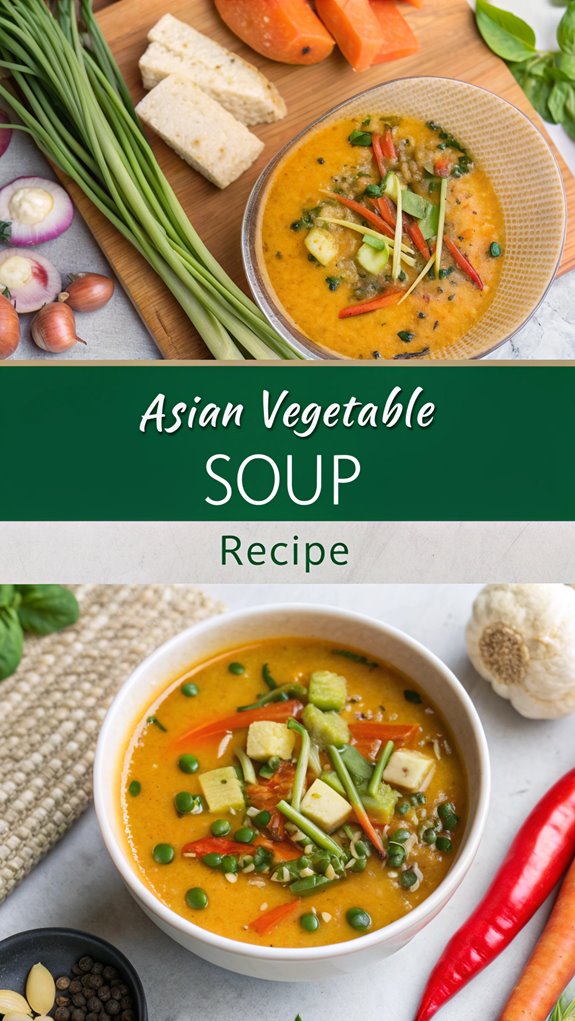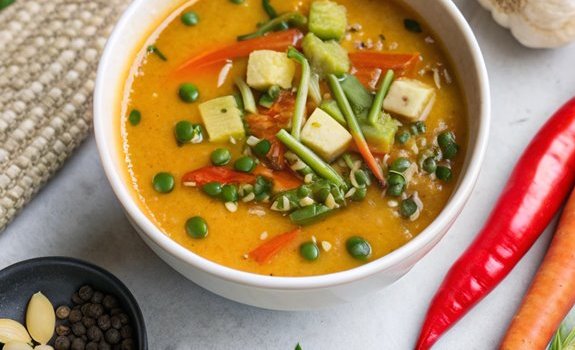Asian Vegetable Soup
You might think Asian Vegetable Soup is just another bland, boring broth, but it’s anything but. This dish not only offers a vibrant medley of flavors and textures, but it also provides a wealth of nutritional benefits that can enhance your meals. Imagine the warmth of a fragrant onion broth paired with the crunch of fresh vegetables and the heartiness of tofu. What’s more, you can easily adapt the recipe to fit your taste preferences and seasonal ingredients, making it a staple in your kitchen. Curious about how to make this comforting dish truly unique?
Why You’ll Love This Recipe
When you’re craving a comforting yet nutritious meal, this Asian Vegetable Soup is the perfect choice. You’ll love how easy it’s to prepare. With a simple onion broth as its base, the soup cooks quickly, allowing you to enjoy all the nutrients from fresh vegetables like bok choy, mushrooms, and cabbage.
Each bowl is packed with fiber, vitamins A, B, and C, and a good amount of protein from tofu, making it a well-rounded meal. This recipe is also highly customizable. You can add your favorite vegetables, adjust the spice level with sriracha, and even toss in gluten-free noodles like shirataki fettuccine. The versatility means you can make it just the way you like it.
Additionally, this soup serves 6, making it an ideal option for family meals or gatherings. Aside from being delicious, this soup offers health benefits, too. The fiber promotes digestive health, while ingredients like ginger help boost your immune system and relieve cold symptoms.
Plus, at about 119 calories per cup, it’s a low-calorie option that leaves you feeling satisfied. So, whether you’re looking to warm up on a chilly day or need a quick meal, this Asian Vegetable Soup has got you covered.
History
The history of soup dates back thousands of years, showcasing humanity’s ingenuity in creating nourishing meals from simple ingredients. Evidence from around 20,000 BC shows that the first soup bowls were found in Xianrendong Cave in China, indicating that people were preparing hot soups long ago. Early methods involved using hot rocks to boil water, allowing for the extraction of fats from bones to create rich broths.
As civilizations grew, so did the variety of soups. The Romans introduced dishes like Gazpacho and Minutal Apicianum, while in 7th century China, the development of wontons added new flavors to soups. Each region began to create unique recipes, influenced by local ingredients and culinary practices. Notably, Neanderthals boiled bones to produce drinkable broth, a practice that laid the groundwork for future soup-making techniques.
In East Asia, soups are categorized as savory or sweet and are appreciated for their health benefits and umami flavors. Traditional Chinese medicine often links soups to restorative properties.
Throughout history, soup hasn’t only provided nourishment but also held cultural significance, becoming a staple in daily meals and special occasions.
The evolution of soup reflects the blending of traditions, showcasing the rich tapestry of culinary history.
Recipe

Asian Vegetable Soup Recipe
This Asian Vegetable Soup is a vibrant and nutritious dish that’s perfect for a cozy night in or as a light lunch. Packed with a variety of fresh vegetables and infused with aromatic flavors, this soup isn’t only delicious but also customizable to suit your taste preferences. The soup is also a low-calorie option that supports healthy eating habits.
Whether you’re vegetarian, vegan, or simply looking to incorporate more vegetables into your diet, this soup is a fantastic option that can be tailored with your favorite ingredients.
The base of the soup features a rich blend of garlic, ginger, and onions that create a fragrant aroma as they sauté in the pot. You can combine any vegetables you have on hand, such as carrots, cabbage, and mushrooms, making it a versatile recipe.
For added protein, consider including tofu, and for a heartier meal, serve it with noodles. This soup is sure to warm your heart and satisfy your taste buds.
Ingredients:
- 2 tablespoons oil
- 4 cloves garlic, minced
- 1-inch piece ginger, minced
- 1 onion, chopped
- 2 carrots, sliced
- 1 cup cabbage, shredded
- 1 cup mushrooms, sliced
- 2 cups leafy greens (baby bok choy or spinach)
- 4 cups vegetable stock or water
- 2 tablespoons low sodium soy sauce
- 1 tablespoon white miso
- 1 teaspoon sriracha or red chili flakes (optional)
- 1 tablespoon apple cider vinegar or lemon juice
- 1 cup cubed tofu (optional)
- Noodles (hakka noodles or shirataki fettuccine)
Cooking Instructions:
- Heat oil in a large pot or Dutch oven over medium heat. Add the minced garlic, ginger, and chopped onion, and sauté until the onion is slightly softened and fragrant, about 3-4 minutes.
- Add the sliced carrots, shredded cabbage, and sliced mushrooms to the pot. Stir-fry the vegetables for another 5 minutes, allowing them to soften slightly and release their flavors.
- Pour in the vegetable stock or water, and bring the mixture to a boil. Once boiling, reduce the heat to a gentle simmer.
- Add the leafy greens, soy sauce, miso, and optional sriracha or red chili flakes. Stir well to combine and simmer for an additional 5-10 minutes, until all the vegetables are tender.
- If using tofu, gently fold in the cubed tofu and simmer for another 2-3 minutes to heat through. Adjust seasoning with salt, pepper, and additional spices if desired.
- If you prefer a thicker soup, mix a tablespoon of cornstarch with a little water to create a slurry, then stir it into the soup and cook for a few more minutes until thickened.
- Serve hot, garnished with additional leafy greens or sliced chili if desired, and enjoy with your choice of noodles.
Extra Tips:
When preparing this Asian Vegetable Soup, feel free to experiment with different vegetables based on the season or what you have at home.
You can also switch up the flavor profile by adding herbs like cilantro or green onions on top for a fresh finish. For a heartier version, consider adding cooked noodles directly into the soup before serving.
Remember to taste and adjust the seasoning as you go for the best results!
Final Thoughts
While this Asian Vegetable Soup is a delightful dish on its own, it also opens the door to a world of culinary exploration. You’ll discover that soups hold a significant cultural place in many Asian traditions. Not only do they provide nourishment, but they also symbolize balance and hospitality. The healing properties of ingredients like ginger and ginseng can boost your health, making this soup more than just a meal. In many East Asian cultures, soups serve as main dishes or simple accompaniments, highlighting their importance in daily meals.
As you prepare your soup, remember that it’s incredibly versatile. You can mix and match ingredients based on what you have at home or what’s in season. This adaptability allows you to cater to different tastes and dietary needs. Use various seasonings to enhance the flavors, creating a dish that’s uniquely yours.
Finally, take your time during the cooking process. Slow cooking not only develops rich flavors but also allows nutrients to infuse into the broth. By embracing traditional methods and regional influences, you not only create a nourishing meal but also connect with the rich history behind Asian soups.
Enjoy your cooking journey, and savor each bowl of this wholesome dish!
FAQ
If you’re curious about making Asian Vegetable Soup or want to explore its many facets, you might’ve some questions. One common query is about the ingredients. You can use leafy greens like bok choy, along with various mushrooms such as white, enoki, or wood ear.
Ginger and garlic are essential for flavor, and don’t forget about low sodium soy sauce and vegetable broth as your base. Additionally, incorporating a variety of vegetables can make the soup more fiber-rich, enhancing its nutritional profile.
When it comes to cooking techniques, you can sauté or simmer ingredients in a large pot. Start by boiling the broth, then reduce the heat. Cooking times typically range from 5 to 20 minutes.
You might also stir-fry ingredients before adding them to the broth for added flavor.
For variations and additions, consider adding noodles like soba or rice noodles, and tofu for protein. You can also include other vegetables like carrots or cabbage.
Be sure to season with salt, pepper, and spices like sriracha for an extra kick. Finally, garnishing with green onions or cilantro can really elevate your dish.
Asian vegetable soup isn’t only tasty but also low in calories and packed with nutrients!

Asian Vegetable Soup
Ingredients
- Ingredients:
- 2 tablespoons oil
- 4 cloves garlic minced
- 1- inch piece ginger minced
- 1 onion chopped
- 2 carrots sliced
- 1 cup cabbage shredded
- 1 cup mushrooms sliced
- 2 cups leafy greens baby bok choy or spinach
- 4 cups vegetable stock or water
- 2 tablespoons low sodium soy sauce
- 1 tablespoon white miso
- 1 teaspoon sriracha or red chili flakes optional
- 1 tablespoon apple cider vinegar or lemon juice
- 1 cup cubed tofu optional
- Noodles hakka noodles or shirataki fettuccine
Instructions
- Cooking Instructions:
- Heat oil in a large pot or Dutch oven over medium heat. Add the minced garlic, ginger, and chopped onion, and sauté until the onion is slightly softened and fragrant, about 3-4 minutes.
- Add the sliced carrots, shredded cabbage, and sliced mushrooms to the pot. Stir-fry the vegetables for another 5 minutes, allowing them to soften slightly and release their flavors.
- Pour in the vegetable stock or water, and bring the mixture to a boil. Once boiling, reduce the heat to a gentle simmer.
- Add the leafy greens, soy sauce, miso, and optional sriracha or red chili flakes. Stir well to combine and simmer for an additional 5-10 minutes, until all the vegetables are tender.
- If using tofu, gently fold in the cubed tofu and simmer for another 2-3 minutes to heat through. Adjust seasoning with salt, pepper, and additional spices if desired.
- If you prefer a thicker soup, mix a tablespoon of cornstarch with a little water to create a slurry, then stir it into the soup and cook for a few more minutes until thickened.
- Serve hot, garnished with additional leafy greens or sliced chili if desired, and enjoy with your choice of noodles.
- Extra Tips:
- When preparing this Asian Vegetable Soup, feel free to experiment with different vegetables based on the season or what you have at home.
- You can also switch up the flavor profile by adding herbs like cilantro or green onions on top for a fresh finish. For a heartier version, consider adding cooked noodles directly into the soup before serving.
- Remember to taste and adjust the seasoning as you go for the best results!



